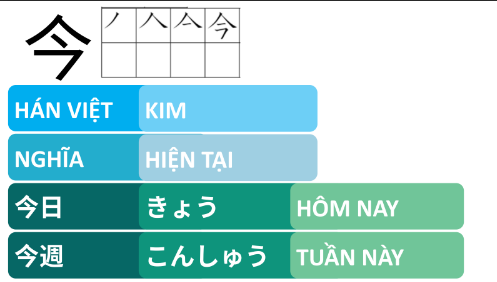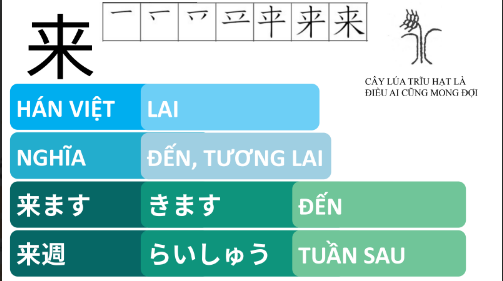


Kanji 今 (Now/This)** * **Kanji:** 今 * **Stroke Order:** Shows the stroke order for the Kanji 今. * **HÁN VIỆT:** KIM * **NGHĨA:** HIỆN TẠI * **Combinations:** * **今日 (kyou):** HÔM NAY * **今週 (konshuu):** TUẦN NÀY **Image 2: Kanji 来 (Come/Next)** * **Kanji:** 来 * **Stroke Order:** Shows the stroke order for the Kanji 来. Also includes a drawing of a tree with an implied meaning. * **HÁN VIỆT:** LAI * **NGHĨA:** ĐẾN, TƯƠNG LAI * **Combinations:** * **来ます (kimasu):** ĐẾN * **来週 (raishuu):** TUẦN SAU **Image 3: Kanji 帰 (Return)** * **Kanji:** 帰 * **Stroke Order:** Shows the stroke order for the Kanji 帰. * **HÁN VIỆT:** QUY * **NGHĨA:** VỀ * **Combinations:** * **帰ります (kaerimasu):** VỀ * **帰国 (kikoku):** VỀ NƯỚC **Image 4: Kanji 会 (Meet/Association)** * **Kanji:** 会 * **Stroke Order:** Shows the stroke order for the Kanji 会. Also includes an illustration of a stack of items. * **HÁN VIỆT:** HỘI * **NGHĨA:** GẶP GỠ * **Combinations:** * **会います (aimasu):** GẶP * **会社 (kaisha):** CÔNG TY
Kanji 生 (Life/Birth/Student)** * **Kanji:** 生 * **Stroke Order Evolution:** Shows the progression of stroke order for the Kanji 生, starting from its components (一, 十, 土) and leading to the final form. Also includes an image of a seedling growing. * **HÁN VIỆT:** SINH * **Meaning:** SINH * **Combined Kanji:** * **Students:** 学 生 (gakusei) – HỌC SINH * **Teacher:** 先 生 (sensei) – THẦY / CÔ **Image 2: Kanji 語 (Language/Word)** * **Kanji:** 語 * **Stroke Order Evolution:** Shows the progression of stroke order for the Kanji 語, starting from its components (言, 吾) and leading to the final form. Also includes an image representing speech or words. * **HÁN VIỆT:** NGỮ * **Meaning:** TIẾNG * **Combined Kanji:** * **Japanese Language:** 日本語 (nihongo) – TIẾNG NHẬT * **Thai Language:** タイ語 (taigo) – TIẾNG THÁI **Image 3: Matching Kanji to Sino-Vietnamese Readings** * **Title:** CHỌN KANJI ĐÚNG VỚI HÁN VIỆT * **Row 1 (TƯ):** Shows four Kanji characters, three of which are 私 (watashi). The correct Kanji for “TƯ” is likely 私. * Kanji presented: 和, 私, 私, 私 * **Row 2 (HỌC):** Shows four Kanji characters, all of which are 学 (gaku). The correct Kanji for “HỌC” is 学. * Kanji presented: 学, 学, 学, 学 * **Row 3 (NGỮ):** Shows four Kanji characters, all of which are 語 (go). The correct Kanji for “NGỮ” is 語. * Kanji presented: 読, 語, 語, 語 **Image 4: Matching Kanji to Sino-Vietnamese Readings (Continued)** * **Title:** CHỌN KANJI ĐÚNG VỚI HÁN VIỆT * **Row 1 (HỌC):** Shows four Kanji characters, all of which are 学 (gaku). The correct Kanji for “HỌC” is 学. * Kanji presented: 学, 学, 学, 学 * **Row 2 (HIỆU):** Shows four Kanji characters. The last one is 校 (kou). The correct Kanji for “HIỆU” (as in trường học) is 校. * Kanji presented: 秘, 私, 談, 校 * **Row 3 (TIÊN):** Shows four Kanji characters. The first two are 先 (sen). The correct Kanji for “TIÊN” (as in thầy giáo) is 先. * Kanji presented: 先, 先, 元, 生 * **Row 4 (SINH):** Shows four Kanji characters. The last one is 生 (sei/shou). The correct Kanji for “SINH” is 生. * Kanji presented: 先, 先, 元, 生
Kanji 社 (Company/Society)** * **Kanji:** 社 * **Stroke Order:** Shows the stroke order for the Kanji 社. Also includes an illustration related to agriculture and harvest. * **HÁN VIỆT:** XÃ * **NGHĨA:** ĐỀN, XÃ HỘI * **Combination:** * **会社 (kaisha):** CÔNG TY **Image 2: Kanji 聞 (Hear/Listen)** * **Kanji:** 聞 * **Stroke Order:** Shows the stroke order for the Kanji 聞. Also includes an illustration of a person with an ear, implying listening. * **HÁN VIỆT:** VĂN * **NGHĨA:** NGHE * **Combinations:** * **聞きます (kikimasu):** NGHE * **新聞 (shinbun):** BÁO **Image 3: Kanji 話 (Speak/Talk)** * **Kanji:** 話 * **Stroke Order:** Shows the stroke order for the Kanji 話. * **HÁN VIỆT:** THOẠI * **NGHĨA:** TRÒ CHUYỆN * **Combinations:** * **話します (hanashimasu):** TRÒ CHUYỆN * **電話 (denwa):** ĐIỆN THOẠI **Image 4: Kanji 読 (Read)** * **Kanji:** 読 * **Stroke Order:** Shows the stroke order for the Kanji 読. * **HÁN VIỆT:** ĐỌC * **NGHĨA:** ĐỌC * **Combination:** * **読みます (yomimasu):** ĐỌC
**語** * HỌC SINH * NGÔN NGỮ * NGƯỜI * **人** * NGƯỜI * SỐNG * NGÔN NGỮ * **生** * TUỔI * NGƯỜI * SỐNG **Image 2:** * **私** * TÔI * NGÀY * TRƯỚC * **日** * NGÀY * TÔI * LỚN * **先** * TRƯỚC * LỚN * TÔI * **大** * TÔI * NGÀY * LỚN **Image 3:** * **校** * TRƯỜNG * LỚN * HỌC * **学** * HỌC * TRƯỜNG * SỐNG * **生** * SỐNG * HỌC * TRƯỜNG * **大** * HỌC * TRƯỜNG * LỚN
Kanji 帰国 (Return to Country)** * **Kanji:** 帰国 * **Hán Việt Columns:** * QUY (VỀ) * QUY QUỐC (VỀ NƯỚC) * AI CHU (TUẦN SAU) * LAI (ĐẾN) * XÃ HỘI * AI (BÂY GIỜ) * THƯ (VIẾT) * HỘI XÃ (CÔNG TY) * AI NGHIỆT (THÁNG SAU) * VĂN (NGHE) * TÂN VĂN (BÁO) * AI NIÊN (NĂM SAU) * ĐỌC * TỔ THƯ QUÁN (THƯ VIỆN) * THOẠI (NÓI) * ĐIỆN THOẠI * HỘI THOẠI (TRÒ CHUYỆN) * **Sentence Examples (Japanese with Vietnamese translation):** * 〜にくい へかえります (ni…) * 〜にほん へかえります (nihon e…) – VỀ NHẬT BẢN * うち へかえります (uchi e…) – VỀ NHÀ * おんがく をききます (ongaku o kikimasu) – NGHE NHẠC * しんぶん をよみます (shinbun o yomimasu) – ĐỌC BÁO * 〜としょかん に いきます (toshokan ni ikimasu) – ĐẾN THƯ VIỆN * ともだち に あいました (tomodachi ni aimashita) – GẶP BẠN BÈ * なんてにききますか (nanji ni kikimasu ka) – MẤY GIỜ THÌ ĐI NGHE? * CD をききます (CD o kikimasu) – NGHE CD * にっき をかきます (nikki o kakimasu) – VIẾT NHẬT KÝ * レポート をかきます (repooto o kakimasu) – VIẾT BÁO CÁO * どこで あいますか (doko de aimasu ka) – GẶP Ở ĐÂU? * でんわ を かけます (denwa o kakemasu) – GỌI ĐIỆN THOẠI * えいご で は なします (eigo de wa hanashimasu) – NÓI BẰNG TIẾNG ANH * にほんご で は なします (nihongo de wa hanashimasu) – NÓI BẰNG TIẾNG NHẬT * てがみ を かきます (tegami o kakimasu) – VIẾT THƯ **Image 2: Matching Kanji to Meaning** * **1. Ý NGHĨA GẶP (HỘI):** * Kanji options: (Illustrations of various characters including 會, which is an older form of 会) * A: (Illustration of 会) * B: (Illustration of 舌) * C: (Illustration of 古) * D: (Illustration of 斧) * **2. Ý NGHĨA BÂY GIỜ (KIM):** * Kanji options: (Illustrations of various characters including 今) * A: (Illustration of 儿) * B: (Illustration of 刀) * C: (Illustration of 今) * D: (Illustration of 刀) * **3. Ý NGHĨA NGHE (VĂN):** * Kanji options: (Illustrations of various characters including 聞) * A: (Illustration of 寺) * B: (Illustration of 舌) * C: (Illustration of 古) * D: (Illustration of 斧) * **1. Ý NGHĨA NÓI CHUYỆN (THOẠI):** * Kanji options: (Illustrations of various characters including 話) * A: (Illustration of 言) * B: (Illustration of 舌) * C: (Illustration of 古) * D: (Illustration of 斧) * **2. Ý NGHĨA ĐIỆN (ĐIỆN):** * Kanji options: (Illustrations of various characters including 電) * A: (Illustration of 寺) * B: (Illustration of 舌) * C: (Illustration of 古) * D: (Illustration of 斧) * **3. Ý NGHĨA VIẾT (THƯ):** * Kanji options: (Illustrations of various characters including 書) * A: (Illustration of 冊) * B: (Illustration of 口) * C: (Illustration of 耳) * D: (Illustration of 門) **Image 3: Choose the correct Kanji for the Sino-Vietnamese Reading** * **Choose the correct Kanji:** 読 * A. ĐỌC * B. NGHE * C. VIẾT, THƯ TỊCH * **Choose the correct Kanji:** 書 * A. TÀI LIỆU, VIẾT * B. GẶP, HỘI HỌP * C. QUAY VỀ * **Choose the correct Kanji:** 帰 * A. ĐẾN, TƯƠNG LAI * B. QUAY VỀ * C. BÂY GIỜ * **Choose the correct Kanji:** 今 * A. HIỆN TẠI * B. TƯƠNG LAI * C. QUÁ KHỨ
*Row 2 (HỌC):** Shows four Kanji characters, all of which are 学 (gaku). The correct Kanji for “HỌC” is 学. * Kanji presented: 学, 学, 学, 学 * **Row 3 (NGỮ):** Shows four Kanji characters, all of which are 語 (go). The correct Kanji for “NGỮ” is 語. * Kanji presented: 読, 語, 語, 語 **Image 4: Matching Kanji to Sino-Vietnamese Readings (Continued)** * **Title:** CHỌN KANJI ĐÚNG VỚI HÁN VIỆT * **Row 1 (HỌC):** Shows four Kanji characters, all of which are 学 (gaku). The correct Kanji for “HỌC” is 学. * Kanji presented: 学, 学, 学, 学 * **Row 2 (HIỆU):** Shows four Kanji characters. The last one is 校 (kou). The correct Kanji for “HIỆU” (as in trường học) is 校. * Kanji presented: 秘, 私, 談, 校 * **Row 3 (TIÊN):** Shows four Kanji characters. The first two are 先 (sen). The correct Kanji for “TIÊN” (as in thầy giáo) is 先. * Kanji presented: 先, 先, 元, 生 *


